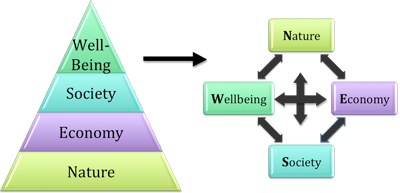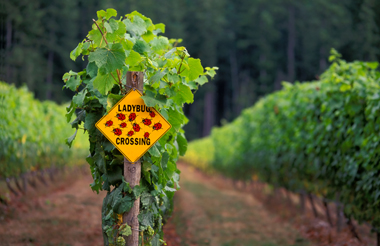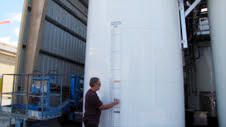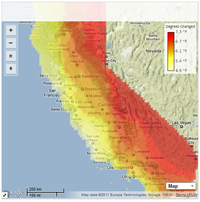Bird's Eye ViewIn the Big Picture view, all business is already located in the context of the environment. Everything any business does has environmental connections. It doesn’t matter where you are located, how many facilities you have, what you produce or what your annual revenues are. Ultimately, there is one defining boundary under which we all live and that is the environment, otherwise known as planet Earth – a finite system. All too often organizational “greening” ends up involving fragmented changes based on ease of implementation, or a focus on visible changes intended to generate customer kudos (e.g. installing a solar array). There is a common failure to account for the Big Picture of business operations – developing a system for continuously tracking resource use, and capitalizing on this system by identifying cost-effective ways to reduce waste and improve efficiency - benefiting your business and the environment. Lacking context, many companies spend money on disconnected fixes that often are not the most efficient investments, and can lead to costly interactions with the “Mis Sisters”—misinformation, miscommunication, misunderstanding and mistakes—often leading to mistrust. Is solar sexy? Yes. But is it saving you money? Not if you don’t maximize energy efficiency first – driving down the size and price of the system you need, and driving up the attraction. In order to most effectively implement a green business program or sustainability initiative you need to find your organization’s place in the Big Picture and plan to increase sustainability the simplest and most sensible way first: no-cost and low-cost changes that save you money. This new perspective of your organization—the Big Picture—will not only provide useful answers, it will provide you with something even more valuable--a more motivated staff asking more strategic questions. Involving your employees and distributors will often lead to the biggest breakthroughs. |

|
Bull’s Eye ViewWhile the almighty dollar is the universal metric, plenty of other data with significant operational value should also be collected, organized and integrated for use with financial decision-making (e.g. energy use, water use and waste per unit of production, all of which feed into your overall carbon footprint). Because these data are often overlooked or underutilized, key decision makers within a company can operate for a very long period with perceptions that are not aligned with actual performance. This can lead to visits from those darn “Mis Sisters”—misinformation, miscommunication, misunderstanding, mistakes, and ultimately, mistrust. The data that needs to be collected to measure performance includes both the technical and the organizational, increasing knowledge and efficiency across the board. This data can be turned into employee awareness programs, provide stories for marketing, serve as the basis for awards and other recognition, attract investors, reassure insurers and so on. One of the first steps on the path to sustainability is measuring performance and perception. This provides not only a snapshot of how the company is actually doing, it also provides the “shared perspective” held by the individuals who make up the organization. Even when motivated to leverage the value of the disparate data that saturates their organizations, many companies fail to tackle the perspective issue. They sacrifice behavioral change for basic efficiency gains when in fact it takes both to align an entire organization to move in a sustainable direction. The most important resource channels to track within any organization tend to be energy consumption, water use, waste generation and greenhouse gas emissions (typically measured as carbon dioxide equivalent, or CO2e). There is an increasing demand among consumers, investors and insurers to know the carbon footprint of business operations. And especially in California, where water shortages are becoming an increasingly pressing issue, there is a need to know how much water is being used per unit of product produced.
Patagonia has created a tool titled “The Footprint Chronicles” that provides one of the best examples we’ve seen of transparency in the full life-cycle analysis of products. |
|
Two Shades of Green
Take a closer look at your current practices and ask the most obvious questions:
This is where ViewCraft comes in. You may be doing several little things already to save energy or increase your recycling rate, but by creating a system to continuously track and monitor resource flows we can help you gain a new perspective and locate even more opportunities to increase efficiency. You will probably be surprised by the number of no- or low-cost changes that can immediately save money, reduce risk, engage employees, enhance market access, improve customer relations and produce valuable gains for your business and the environment. Once you establish meaningful metrics and begin measuring performance, you can create a shift in perception and practices within your company that creates permanent, lasting positive change--not just window dressing; your business can transcend the superficial fixes most companies call “sustainable practices” and move ahead to achieve the gold standard of truly successful companies—full employee and customer engagement and buy-in. |
|
||||||
 |
How do you define sustainability?
 There are more reports and studies available on what “sustainability” means than you can shake a consultant at. All of these results point to the fact that by and large, a majority of employees and consumers are confused by the term, and when pressured to pick a definition usually choose one associated with environmental preservation for future generations, which has become so clichéd it really doesn’t resonate.
There are more reports and studies available on what “sustainability” means than you can shake a consultant at. All of these results point to the fact that by and large, a majority of employees and consumers are confused by the term, and when pressured to pick a definition usually choose one associated with environmental preservation for future generations, which has become so clichéd it really doesn’t resonate.
Of course the results change as the question is posed to those in senior management, where the term is often associated with the economic “E” of the sustainability trinity. The management mantra is that all environmental considerations must be linked with economic measures. But what about aspects of your business that can’t be measured or have intangible values? The ROI argument can almost always be made, but then there are harder things to quantify like how much being a green business increases employee retention, reduces injury and illness, increases informal marketing in face-to-face interactions between employees and customers, etc.
Social sustainability is often conspicuously absent in most discussions or definitions of sustainability, known as the social equity “E”. It is ironic that the majority of people overlook this aspect of sustainability. We are beginning to hear businesses talk about sustainability in terms of employee security, healthcare, housing, years of service. Seghesio Winery is an example of one business we’ve worked with that includes social sustainability front and center in their definition of sustainability.
Defining sustainability comes back to that bird’s eye view – determining your priorities and how they fit in that Big Picture. Without a common definition of sustainability, coupled with a committed environmental education program within the company, most efforts to infuse “greenness” will generate small technological changes for efficiency at best, and generate significant amounts of workplace resentment at worst. Finding a common definition is critical to generating the elixir of shared understanding - that alchemical potion distributed to all people in the organization that allows them all to align in the same direction. Without it, organizational fragmentation occurs, leading to a host of problems.





 In the Winery: Within the wine industry the environmental lens is no longer focused solely on vineyard operations and the benefits of “sustainable”, organic and biodynamic farming practices. There is now a significant focus on the production side of operations as well, with questions about how companies are working to improve resource efficiency and eliminate harmful emissions. As a result we’re beginning to see internal dialogues taking shape around how much electricity and fuel is being used per gallon or case of wine produced, and what the associated emissions are. Many wineries are also beginning to assess their water use per gallon or case of wine produced. It is important to establish these baselines and performance metrics so businesses can begin to track and record continuous improvements over time.
In the Winery: Within the wine industry the environmental lens is no longer focused solely on vineyard operations and the benefits of “sustainable”, organic and biodynamic farming practices. There is now a significant focus on the production side of operations as well, with questions about how companies are working to improve resource efficiency and eliminate harmful emissions. As a result we’re beginning to see internal dialogues taking shape around how much electricity and fuel is being used per gallon or case of wine produced, and what the associated emissions are. Many wineries are also beginning to assess their water use per gallon or case of wine produced. It is important to establish these baselines and performance metrics so businesses can begin to track and record continuous improvements over time.

